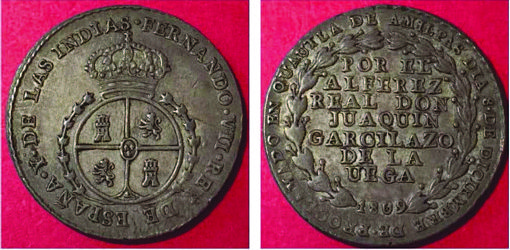Proclamation Medals of Colonial Mexico
by William Sigl Sr.
Proclamation medals of Colonial Mexico are perhaps the least understood field of Mexican numismatics.
The concept of ‘Commemorative‘ has evolved over time
Today‘s collectors are aware of modern Mexican medals and US Commemorative coins. In modern times ’Commemoratives‘ are produced by a government or entity to raise money by selling a coin or medal to the public in celebration of a past historical event of importance. All issues of American Commemorative coins, and most modern Mexican medals can be classified as ’Commemoratives‘. Thus it is natural that today‘s collectors also think of Spanish Colonial Proclamation medals as ’Commemoratives‘.
Proclamation medals from Colonial Mexico were not produced to honor any past historic event. They were produced to serve as a memento of a CURRENT event of historical significance. Proclamation medals were not produced primarily to raise funds, but to be given away for the creation of good will among the ruling elite, and also those who were governed by them.
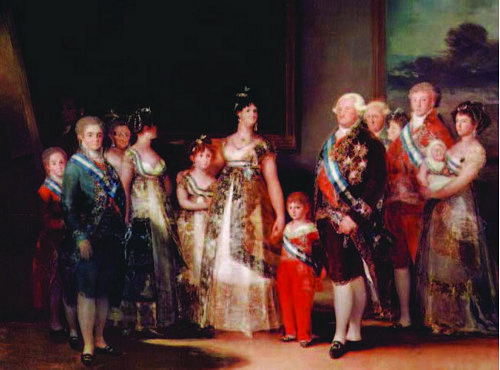
Painting by Francisco Goya of the royal family of Carlos IV in 1800
At the time of the production of the proclamation medals, ’Commemoratives‘ were a relatively foreign concept in Spain and her possessions. In the Spanish Empire during that period (1701 to 1820) no medal that I know of was ever produced solely to commemorate a past historical event. Minor exceptions such as f055-f057 exist, which only commemorate the anniversary of a city‘s founding relative to the date that Fernando VII was crowned.
Note: Through this series of articles I will refer to individual proclamation medals by their Grove number. These are from Frank Grove‘s book entitled Medals of Mexico, Vol 1, Medals of the Spanish Kings (1976.) Several good books have been produced over the past 150 years that pretty much identify all of the issues. Books that I have seen are the following:
Herrera Medallas de Proclamaciones y Juras de los Reyes en España
Grove Medals of Mexico, Vol 1, Medals of the Spanish Kings
Medina Medallas de Proclamaciones y Juras de los Reyes de España en América
The bad news is that originals of these books are rare and expensive. The good news is that several of them have been reprinted in modern times, and are still rather available and inexpensive (less than $100 each)..
Many medals were struck during this period in Spain and her colonies, but they were always struck to commemorate a current event of historical importance. For example, there were no medals struck to commemorate the 300th anniversary of Columbus‘s discovery of the New World in 1792. There were no commemorative medals for centennial celebrations of the Hapsburg dynasty, or 100 years of Bourbon rule of Spain in 1801, or any anniversaries of the Reconquista of Spain.
Why were Proclamation Medals produced?
In colonial Mexico, the production of medals are usually associated with a new king on the Spanish throne. Such medals are called ’Proclamation‘ medals because they were issued to celebrate days of political importance in Spanish colonial life when people of great political power would publicly proclaim their allegiance to the new king.
There are a few instances of Mexican colonial medals that are not associated with a proclamation ceremony. Even these medals were universally still associated with a current event or ceremony.
The best way to view Spanish Colonial proclamation medals from Mexico is as an historical artifact of the colonial political system. During colonial times the production of proclamation medals was popular because they served a very useful political function during a period of absolute monarchy and slow communication. Well designed and produced pieces could be placed in the hands of important people in Europe, thus improving the status and reputation of political appointees, colonial cities, and institutions back in Mexico.
Being an artifact of the Spanish colonial political system is of primary importance as an item to collect, study and curate. It makes these medals more important historically than those of any other area of Mexican numismatics. Owning such artifacts gives the collector a true piece of history, and a direct link to the ruling elite at the time. Production of proclamation medals was a political tool for the colonial ruling elite.
I have repeatedly qualified these statements with references to Mexico. The reason is that I am not sure the same justification existed for the production of proclamation medals in all of the Spanish colonies. For some of the issues from Peru, Bolivia, and Argentina, there are too many surviving examples for me to say that their production was mainly for political purposes.
After the overthrow of Iturbide, the reason for producing proclamation medals seem to have changed. This shift corresponds to the way Mexican politics shifted during this same time.
Traditional vs Pragmatic Definition of Proclamation Medals
There is a difference of opinion among authors and collectors over the definition of what a proclamation medal really is. These differences can be referred to as the ’Traditional‘ and the ’Pragmatic‘ view.
Traditionalists would say that a medal from the Spanish Empire is considered a proclamation medal only if it commemorates a proclamation event. The Traditionalists‘ definition of a proclamation medal is laid out in the books by Herrera and Medina, as well as other Spanish-speaking authors. The thought behind the Traditionalist‘s classification is that of elevating the importance of medals produced for political reasons above that of medals produced purely for the commemoration of other current events. Many Traditionalists may collect both proclamation medals and commemorative types of medals, but they always keep the separation in their minds, and in their auction catalogs.
Pragmatists view any medal produced in the Spanish Empire as a proclamation medal. Most of the collectors with a Pragamatic view are American and Canadian collectors who follow Grove‘s writings. Theirs is a rather relaxed philosophy of collecting based on the pure fun and challenge of collecting such medals, rather than embracing a cultural political view. The Pragmatists‘ thinking is that the more medals there are to collect, the more fun and challenge can be had. Rather than being burdened down by the confines of cultural traditions, the Pragmatists are creating their own traditions.
Neither the Traditionalists nor Pragmatists can be said to be wrong. Both are just a different way of collecting Spanish Colonial Medals.
Categories of Proclamation Medals
The remainder of this article will present the six categories of Colonial Mexican proclamation medals, defined by the Pragmatists. These categories are based on who commissioned the medal, and the medal‘s intended purpose. Where medals are referred to by number it is the Grove numbers as laid out in his book. Most medals were struck in bronze, silver, and sometimes gold, with each striking having its own Grove Number. Since all carry the same design, I have omitted reference to the mention of the subtypes.
1) Commissioned by localities to celebrate Proclamation ceremonies
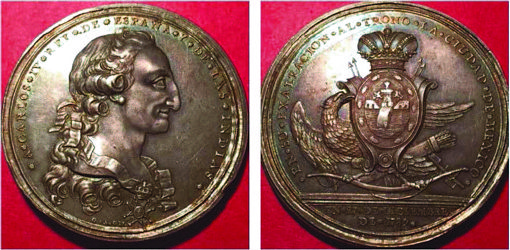 Grove C003a, struck by Mexico City in 1789 for a proclamation ceremony
Grove C003a, struck by Mexico City in 1789 for a proclamation ceremony
Medals in this category can be identified because they always have the name of a city or state on the medal, without any mention of a person, office, or commercial interest.
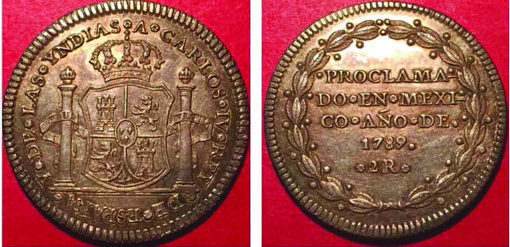 Grove C011. This is part of a series of generic medals for distribution at proclamation ceremonies.
Grove C011. This is part of a series of generic medals for distribution at proclamation ceremonies.
All Colonial Mexico Proclamation Medals struck during the reign of Phillip V and Luis I were struck by local governments. Each succeeding monarch had many or most of the proclamations struck by local governments too, but there was an increasing trend toward the commissioning of proclamation medals by individuals, offices, and commercial interests.
The medals in this category are as follows:
| Phillip V | PV001 | PV002 | PV009 | |||||||
| Luis I | LI001 | LI002 | LI004 | LI005 | LI010 | LI012 | LI014 | LI016 | LI017 | LI018 |
| LI019 | LI020 | LI023 | ||||||||
| Fernando VI | F6-1 | F6-3 | F6-8 | F6-10 | F6-12 | F6-14 | F6-15 | F6-16 | F6-20 | F6-25 |
| F6-26 | F6-27 | F6-29 | F6-30 | F6-32 | F6-34 | F6-36 | F6-37 | F6-38 | F6-40 | |
| Carlos III | K001 | K002 | K003 | K017 | K024 | K028 | K029 | K030 | K032 | K033 |
| K034 | K035 | K037 | K039 | K040 | K041 | K043 | K044 | K045 | K050 | |
| K056 | K060 | K062 | K063 | K066 | K067 | |||||
| Carlos IV | C001 | C002 | C003 | C004 | C006 | C007 | C009 | C010 | C011 | C012 |
| C013 | C014 | C015 | C016 | C018 | C050 | C056 | C059 | C061 | C062 | |
| C072 | C073 | C074 | C080 | C081 | C082 | C083 | C084 | C089 | C090 | |
| C091 | C094 | C095 | C096 | C097 | C098 | C099 | C103 | C104 | C106 | |
| C107 | C109 | C113 | C118 | C119 | C120 | C122 | C123 | C125 | C126 | |
| C127 | C129 | C132 | C133 | C135 | C137 | C139 | C140 | C142 | C144 | |
| C173 | C176 | C177 | C178 | C179 | C180 | C183 | C185 | C186 | C188 | |
| C190 | C191 | C192 | C194 | C196 | C197 | C207 | C208 | C209 | C210 | |
| C211 | C212 | C213 | C214 | C215 | C216 | C217 | C218 | C220 | C221 | |
| C222 | C225 | C228 | C231 | C252 | C253 | C254 | C256 | C257 | C260 | |
| C262 | ||||||||||
| Fernando VII | F001 | F002 | F005 | F010 | F013 | F015 | F016 | F017 | F019 | F040 |
| F041 | F042 | F055 | F056 | F057 | F058 | F059 | F060 | F072 | F074 | |
| F075 | F076 | F077 | F078 | F081 | F083 | F087 | F088 | F089 | F090 | |
| F092 | F096 | F101 | F102 | F105 | F108 | F109 | F111 | F113 | F115 | |
| F145 | F146 | F147 | F154 | F168 | F176 | F177 | F178 | F179 | F181 | |
| F182 | F183 | F184 | F194 | F195 | F196 | F197 | F236 ?? |
2) Commissioned by named officials to celebrate Proclamation ceremonies
Medals in this category can be identified because they always have the name of an official and a location on the medal. Sometimes these medals were the size of 1/2 real, and sometimes they were larger than an 8 reales and made of gold.
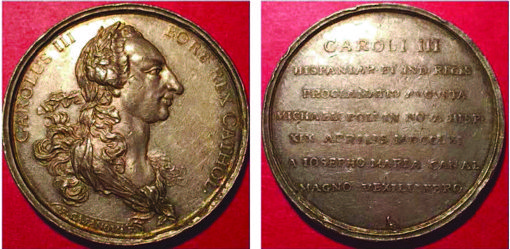 Grove K052, commissioned by Josepho María Canal in 1761 for a proclamation ceremony
Grove K052, commissioned by Josepho María Canal in 1761 for a proclamation ceremony
Most issues were rather plain in design, and presumably intended to be tossed to the crowd from a balcony after the ceremony, but many had designs that were masterworks of the engraver‘s art.
Many of the designs were struck in bronze, silver, and gold. Often sets of the medal in each of the bronze, silver, and gold strikings were sent off as presentations to important people in the Spanish Court, the royal family, and monarchs of allied countries. These seem to have served the same purpose that a business card would serve today. They let each recipient know that they were important to the person who commissioned the medal, and kept that person prominent in their minds.
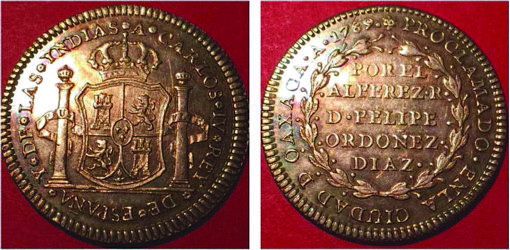 Grove C092, commissioned by Filipe Ordóñez Díaz in Oaxaca in 1789
Grove C092, commissioned by Filipe Ordóñez Díaz in Oaxaca in 1789
Grove F048, commissioned by Joaquín Garcilazo in 1809 for a proclamation ceremony
This category seem to have great historical interest. They were made by important men and women to be given to important men and women, or to be given to the governed as a token of the official‘s benevolence. An interesting note is that in Spain itself it was almost unknown for an individual to commission a proclamation medal and put his name on it.
This category of medal was first commissioned in 1747 in the reign of Fernando VI, and was continued in every succeeding monarch after that. Thus we see that the idea of an individual official commissioning a proclamation medal took almost 50 years to originate after proclamation medals were first struck in colonial Mexico. It seems to have originated in the colonies, as I cannot see any proclamation medals produced in Spain at this time that were commissioned by named
officials.
There must have been real benefits that accrued to those who commissioned such medals because the practice continued and expanded through colonial times.
The medals in this category are as follows:
| Phillip V | none | |||||||||
| Luis I | none | |||||||||
| Fernando VI | F6-42 | |||||||||
| Carlos III | K021 | K052 | K054 | K058 | ||||||
| Carlos IV | C041 | C042 | C043 | C044 | C045 | C046 | C047 | C048 | C058 | C060 |
| C064 | C065 | C066 | C067 | C068 | C069 | C078 | C092 | C093 | C130 | |
| C152 | C153 | C156 | C157 | C158 | C159 | C160 | C161 | C162 | C163 | |
| C166 | C167 | C169 | C170 | C201 | C202 | C203 | C204 | C206 | C230 | |
| C234 | C235 | C239 | C240 | C241 | C244 | C245 | C248 | |||
| Fernando VII | F007 | F045 | F046 | F048 | F095 | F135 | F136 | F137 | F139 | F140 |
| F141 | F143 | F150 | F151 | F153 | F155 | F156 | F158 | F160 | F162 | |
| F164 | F165 | F171 | F174 | F175 | F188 | F192 | F202 | F203 | F204 | |
| F206 | F207 | F208 | F210 | F211 |
3) Commissioned by political institutions or offices to celebrate a new king
Medals in this category will always have the name of the office or institution on the medal. Often times the same office issued proclamation medals for each king, and in order to have better recognition, they would have a similar design and symbolism over the span of years.
 Grove C021a, commissioned by the Archbishop of Mexico
Grove C021a, commissioned by the Archbishop of Mexico
 Grove C036b, commissioned by the Mexico City University in 1790
Grove C036b, commissioned by the Mexico City University in 1790
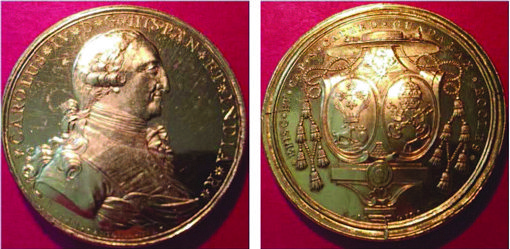 C071gbp (bronze gold plated), commissioned by Guadalajara‘s bishop in 1790 or 1791
C071gbp (bronze gold plated), commissioned by Guadalajara‘s bishop in 1790 or 1791
This category of medal was first commissioned in 1747 in the reign of Fernando VI, and was continued in every succeeding monarch after that. Symbolism is very pronounced on such medals, as it was as much the symbols in the design as much as the words itself that announced the producer of each medal.
The medals in this category are as follows:
| Phillip V | none | |||||||||
| Luis I | none | |||||||||
| Fernando VI | F6-5 | F6-6 | F6-17 | |||||||
| Carlos III | K005 | K006 | K007 | K008 | K011 | K019 | K025 | K026 | ||
| Carlos IV | C020 | C021 | C024 | C025 | C026 | C027 | C028 | C030 | C036 | C052 |
| C053 | C054 | C070 | C071 | C131 | ||||||
| Fernando VII | F028 | F029 | F030 | F032 | F033 | F034 | F035 | F036 | F052 | F061 |
| F062 | F063 | F064 | F065 | F070 | F085 | F086 | F098 | F200 |
4) Commissioned by industrial or commercial groups to celebrate a new king
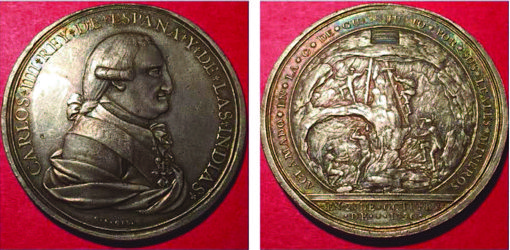 C075a, commissioned by the miners in Guanajuato in 1790
C075a, commissioned by the miners in Guanajuato in 1790
Medals in this category will always make reference to a non governmental commercial group, and usually also make reference to a proclamation event. A distinguishing feature of such medals is that they almost always are very well designed and engraved by the most skilled engravers in New Spain.
This category of medal was first commissioned in 1747 in the reign of Fernando VI. These were not commissioned as frequently as for other categories. This could be perhaps explained by the relative lack of industrial groups in Colonial Mexico that were wealthy enough to commission medals worthy of distribution.
The medals in this category are as follows:
| Phillip V | none | |||||||||
| Luis I | none | |||||||||
| Fernando VI | F6-18 | |||||||||
| Carlos III | none | |||||||||
| Carlos IV | C032 | C033 | C034 | C075 | C076 | C077 | ||||
| Fernando VII | F024 | F066 | F199 |
5) Commissioned to commemorate special events not associated with a coronation
Medals in this category can be identified because they commemorate an event that is not associated with a newly crowned monarch. This category is usually very well designed and engraved.
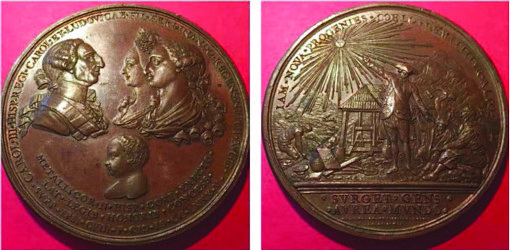 Grove K082b, struck by Mexico‘s miners in 1785 to commemorate the birth of Prince Ferdinand
Grove K082b, struck by Mexico‘s miners in 1785 to commemorate the birth of Prince Ferdinand
In the turbulent reign of Fernando VII, there were many more medals in this category than in prior reigns. The reason is the greater number of political events occurring on the Iberian peninsula, and in Mexico, at the time.
This is a VERY IMPORTANT group of medals. During Fernando VII‘s early reign, he was held captive by the French. A series of medals were issued in Mexico to commemorate support of the king during this troubling time. In the books by Medina and Herrera, such medals are listed as Proclamation Medals, when they are clearly commemorating a non proclamation event. This is proof that the Traditionalists have crossed their logical wires. Their definition of a proclamation medal thus
seems to be any medal produced within a year or two of a new monarch‘s coronation.
The medals in this category are as follows:
| Phillip V | none | |||||||||
| Luis I | none | |||||||||
| Fernando VI | none | |||||||||
| Carlos III | K070 | K075 | K076 | K078 | K080 | K082 | K084 | |||
| Carlos IV | C265 | C267 | C268 | |||||||
| Fernando VII | F020 | F021 | F022 | F023 | F026 | F031 | F049 | F067 | F120 | F122 |
| F124 | F125 | F127 | F128 | F130 | F131 | F132 | F180 | F186 | F190 | |
| F198 | F219 | F227 |
6) Made as an Award
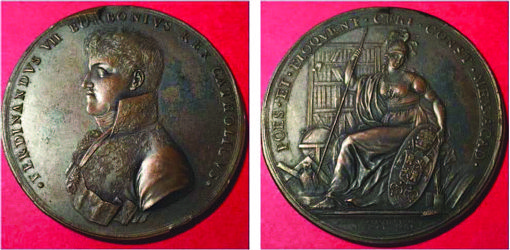 Grove F038a, commissioned by Mexico University in 1809 for a literary contest
Grove F038a, commissioned by Mexico University in 1809 for a literary contest
Medals in this category are usually easy to spot, but sometimes you have to read the books to find the purpose of the medal. Usually such medals will have ‘Al Merito‘ or ‘PREMIO‘ on the reverse. But in the case of F038, the purpose of this medal seems to have been for a prize for a literary contest. This seems to be supported by the large numbers that are encountered in lower grades (they seem to have survived in greater numbers as cherished heirlooms).
With some of these medals, for example C272 (a religious medal) and C275 (a uniface pattern for a military decoration), even with my Pragmatic definition of what a proclamation medal is, I have a feeling that including these is a real stretch of the definition. However the intent of the Pragmatic view is that inclusion of more medals increases the fun of collecting them. Thus I do not mind collecting these marginal issues when I see them.
Some of the medals produced during the time of Fernando VII seem to be awards for valor and loyalty during times of trouble.
The medals in this category are as follows:
| Phillip V | none | |||||||||
| Luis I | none | |||||||||
| Fernando VI | none | |||||||||
| Carlos III | K090 | K092 | ||||||||
| Carlos IV | C085 | C086 | C087 | C272 | C275 | C283 | ||||
| Fernando VII | F038 | F068 | F229 | F230 | F232 |
Summary
This article has hopefully introduced you to the excitement and rewards of studying and collecting Colonial Mexican Proclamation Medals. Despite numerous books having been written about these medals over the last 150 years, there is a lot of discoveries yet to be made. Categorization of these medals is a tool to facilitate the study of them in order to uncover indications of their use and importance at the time of their production, and their role in Colonial political life.
Finally we have the different points of view between the Traditionalists and Pragmatists, two schools of thought among modern day collectors of these medals

